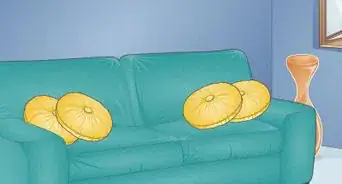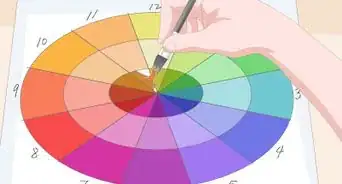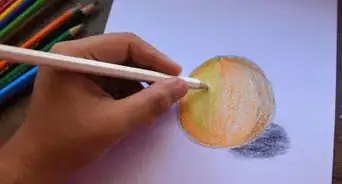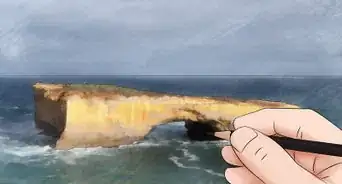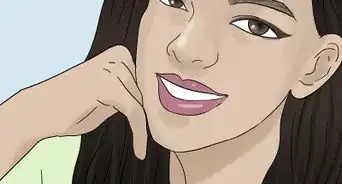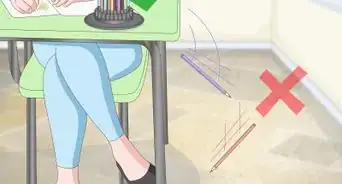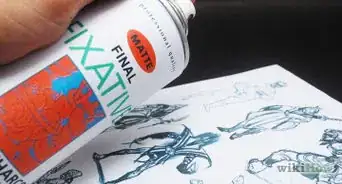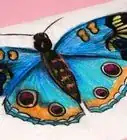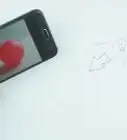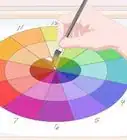This article was co-authored by Veronica Winters. Veronica Winters is a Figurative Artist who owns an online art gallery and studio in Naples, Florida. With over 20 years of experience, Veronica specializes in surreal figurative oil paintings and colored pencil drawings. In 2022, she won the Award for Distinction at the 30th Annual Colored Pencil Society of America International Exhibition. Veronica is also a published author of two art books: How to Color Like an Artist and The Colored Pencil Manual. She received her BFA in Studio Art at Oklahoma State University and her MFA in Painting at Pennsylvania State University. Veronica also studied classical drawing at the Grand Central Academy of Art and the Art Students League of New York.
There are 10 references cited in this article, which can be found at the bottom of the page.
This article has been viewed 41,942 times.
Coloring is a great activity that can be enjoyed by children and adults alike. It’s relaxing, inexpensive, and an ideal way to get creative without needing many supplies. To begin coloring, choose what you want to color and the tools that you want to use. Then begin coloring and try not to worry about making mistakes; simply enjoy the process! There are plenty of options for coloring such as books, pages printed from the internet, and apps.
Things You Should Know
- Color in the same direction and from the outside of the drawing in for the best results.
- Color shadows darker and highlights lighter to add depth and dimension to your drawing.
- Add more layers to darken colors instead of pressing down harder with your crayon or colored pencil.
Steps
Using Coloring Techniques
-
1Pick the tools that you want to color with. While coloring is traditionally done with crayon, use any tools that you feel comfortable with. You can try using fine-tip permanent markers, gel pencils, crayons, and different types of pencils such as watercolor. Regardless of the type of tool that you choose, look for a set that has a wide variety of different colors so that you can experiment with different techniques such as shading.[1]
- If you are using colored pencils, sharpen them well before you begin.
- If you are using permanent markers, consider testing if they will bleed through the page first. Pick an inconspicuous area to test in and place an extra piece of paper underneath to protect the other pages if necessary.[2]
-
2Use light layers and gradually build up the layers to darken the color. Especially when using colored pencils, it’s very important to gradually darken the color using multiple layers. Begin with gentle pressure to create light layers and with each additional layer press down slightly more until the color reaches the desired tone.[3]
- Making sure that you don’t press too hard with the colored pencils will also prevent them from breaking.
- If you want to make sure that you get the colors right, get a scrap piece of paper and try drawing swatches with the same colored pencil using different amounts of pressure. You can use the swatches as a reference point to decide how much pressure you want to use while coloring.[4]
Advertisement -
3Color in the same direction and from the outside in to keep it neat. Start from the outside of a section and work your way towards the center as you color. Try to color in the same direction at all times if possible, so that the strokes look neat and tidy.
- This technique will help you to avoid accidentally coloring outside the lines.
-
4Experiment with different techniques to become more creative as you color. Try shading by using a combination of light and dark tones to show where the aspects of your drawings that are highlighted. You can also try cross hatching by adding intersecting lines to create dimension.[5]
- Alternatively, an easy technique to try is crayon rubbings. Simply remove the paper from the crayon, lay it on its side, and rub it gently over the paper. This creates a gentle shade over the paper. You can also try putting paper or cardboard shapes beneath the coloring page and using the crayon rubbings method to create new shapes on your picture.[6]
-
5Take your time to enjoy coloring. Use your time coloring to enjoy being in the moment and focusing on the task at hand. Try not to worry about making mistakes or if the colors don’t look right. Remember that the purpose of coloring is to enjoy being creative. You can always start on a new picture or page if you need to.[7]
- Color however you feel is best. You can experiment with different designs, colors, and patterns, or keep it simple depending on what works for you.
Choosing What to Color
-
1Use a coloring book to have a variety of pictures to choose from. Coloring books are inexpensive and they can be purchased from bookstores, department stores, or online. There is a wide variety of themes to choose from depending on your interests including comics, movies, nature, and animals.[8]
- Coloring books are a great option to pick if you don’t want to create your own drawings or if you want to color a lot.
-
2Print out online coloring pages if you want specific pictures to color. There is a huge variety of coloring pages that are available online for free. Use a search engine to find the pictures that you are looking for, such as specific cartoon characters or animals. Then print as many copies of the coloring pages as you prefer.[9]
- Printing out coloring pages from the internet is the best way to get multiple copies of the same picture, as you don't need to buy duplicates of the same book. This can be useful if you have children or are hosting a kid's birthday party.
-
3Color your own drawings to make your own art. Coloring your own pictures is a great way to get creative and to have the freedom to color any design that you want. Trace your favorite pictures or use your imagination to create cartoons, patterns, lettering, or still life drawings.[10]
- Cartoons, people, animals, houses, and cars are all popular choices.
-
4Use an app to color on your smartphone or tablet. If you want to color while you are out and about and you don’t want the hassle of carrying a coloring book with you, then an app is the way to go. Search for and download your favorite coloring apps so that you can color at any time.[11]
- Coloring apps are great because you have a wide variety of different options to color, without having to carry around multiple coloring books, pages, and tools.
- If you make a mistake while coloring using an app, it is much easier to remove than coloring with pencils or markers on paper.
Expert Q&A
-
QuestionIs it possible to erase anything I've done with colored pencils?
 Veronica WintersVeronica Winters is a Figurative Artist who owns an online art gallery and studio in Naples, Florida. With over 20 years of experience, Veronica specializes in surreal figurative oil paintings and colored pencil drawings. In 2022, she won the Award for Distinction at the 30th Annual Colored Pencil Society of America International Exhibition. Veronica is also a published author of two art books: How to Color Like an Artist and The Colored Pencil Manual. She received her BFA in Studio Art at Oklahoma State University and her MFA in Painting at Pennsylvania State University. Veronica also studied classical drawing at the Grand Central Academy of Art and the Art Students League of New York.
Veronica WintersVeronica Winters is a Figurative Artist who owns an online art gallery and studio in Naples, Florida. With over 20 years of experience, Veronica specializes in surreal figurative oil paintings and colored pencil drawings. In 2022, she won the Award for Distinction at the 30th Annual Colored Pencil Society of America International Exhibition. Veronica is also a published author of two art books: How to Color Like an Artist and The Colored Pencil Manual. She received her BFA in Studio Art at Oklahoma State University and her MFA in Painting at Pennsylvania State University. Veronica also studied classical drawing at the Grand Central Academy of Art and the Art Students League of New York.
Figurative Artist Usually, you can't erase colored pencils completely, especially when the line or shading is very strong. However, a Tombow mono eraser is a great tool to use for quick fixes and touch-ups. It gets deep into the surface, which is awesome when you need to erase highly saturated or dark colors. It's also great because it's so small, which helps when you need a lot of precision to touch up tiny areas like the eyes in your drawing. If you are going to erase anything you've made with colored pencils, avoid using lots of pressure because it alters the paper's surface. If your paper is low quality and very thin, you might rip or warp it.
Usually, you can't erase colored pencils completely, especially when the line or shading is very strong. However, a Tombow mono eraser is a great tool to use for quick fixes and touch-ups. It gets deep into the surface, which is awesome when you need to erase highly saturated or dark colors. It's also great because it's so small, which helps when you need a lot of precision to touch up tiny areas like the eyes in your drawing. If you are going to erase anything you've made with colored pencils, avoid using lots of pressure because it alters the paper's surface. If your paper is low quality and very thin, you might rip or warp it. -
QuestionWhat's a way to add some texture after I've colored my image?
 Veronica WintersVeronica Winters is a Figurative Artist who owns an online art gallery and studio in Naples, Florida. With over 20 years of experience, Veronica specializes in surreal figurative oil paintings and colored pencil drawings. In 2022, she won the Award for Distinction at the 30th Annual Colored Pencil Society of America International Exhibition. Veronica is also a published author of two art books: How to Color Like an Artist and The Colored Pencil Manual. She received her BFA in Studio Art at Oklahoma State University and her MFA in Painting at Pennsylvania State University. Veronica also studied classical drawing at the Grand Central Academy of Art and the Art Students League of New York.
Veronica WintersVeronica Winters is a Figurative Artist who owns an online art gallery and studio in Naples, Florida. With over 20 years of experience, Veronica specializes in surreal figurative oil paintings and colored pencil drawings. In 2022, she won the Award for Distinction at the 30th Annual Colored Pencil Society of America International Exhibition. Veronica is also a published author of two art books: How to Color Like an Artist and The Colored Pencil Manual. She received her BFA in Studio Art at Oklahoma State University and her MFA in Painting at Pennsylvania State University. Veronica also studied classical drawing at the Grand Central Academy of Art and the Art Students League of New York.
Figurative Artist Once you've colored in your drawing, take out a Tombow mono eraser and use different strokes to create special textures or effects that add realism or creativity to your illustration.
Once you've colored in your drawing, take out a Tombow mono eraser and use different strokes to create special textures or effects that add realism or creativity to your illustration. -
QuestionHow can you use complimentary colors?
 Renée PlevyRenée Plevy is an Internationally Acclaimed Portrait Artist from New York/Palm Beach who has painted The Grand Dames of Palm Beach and various celebrities and community leaders. With over 50 years of experience, Renée specializes in painting realistically in oil and capturing the soul of the person. She has studied under internationally renowned portrait artists John Howard Sanden, David Leffel, Robert Beverly Hale, Clyde Smith, and Leonid Gervits. Renée is featured in over 68 shows and galleries including a one-woman museum show at the Paterson Museum. She has garnered numerous awards including “Artist of the Year” from The Bloomfield Art League and First Prize from the Boca Raton Museum Artist’s Guild. Renée has even painted a portrait of celebrity, Vanilla Ice. She also teaches at the Boca Raton Museum Art School - formerly at SVA in Manhattan.
Renée PlevyRenée Plevy is an Internationally Acclaimed Portrait Artist from New York/Palm Beach who has painted The Grand Dames of Palm Beach and various celebrities and community leaders. With over 50 years of experience, Renée specializes in painting realistically in oil and capturing the soul of the person. She has studied under internationally renowned portrait artists John Howard Sanden, David Leffel, Robert Beverly Hale, Clyde Smith, and Leonid Gervits. Renée is featured in over 68 shows and galleries including a one-woman museum show at the Paterson Museum. She has garnered numerous awards including “Artist of the Year” from The Bloomfield Art League and First Prize from the Boca Raton Museum Artist’s Guild. Renée has even painted a portrait of celebrity, Vanilla Ice. She also teaches at the Boca Raton Museum Art School - formerly at SVA in Manhattan.
Portrait Artist & Educator Mix complimentary colors together to tone down the brightness of a color and make the color look deeper. For instance, mix a little green in to tone down a bright red. Or you can do what Van Gogh did and put complimentary colors next to each other (like blue and yellow). That adds a lot of energy.
Mix complimentary colors together to tone down the brightness of a color and make the color look deeper. For instance, mix a little green in to tone down a bright red. Or you can do what Van Gogh did and put complimentary colors next to each other (like blue and yellow). That adds a lot of energy.
References
- ↑ https://diycandy.com/coloring-for-adults-101-your-complete-guide/
- ↑ http://coloringbookaddict.com/adult-coloring-books-top-13-tips-for-new-colorists/
- ↑ https://www.art-is-fun.com/how-to-erase-colored-pencils/
- ↑ https://www.mybluprint.com/article/6-techniques-to-up-your-colored-pencil-game
- ↑ https://mymodernmet.com/colored-pencil-techniques/
- ↑ http://www.preschoolexpress.com/learning-station10/learning-with-crayons-august.shtml
- ↑ http://coloringbookaddict.com/adult-coloring-books-top-13-tips-for-new-colorists/
- ↑ https://edition.cnn.com/2016/01/06/health/adult-coloring-books-popularity-mental-health/index.html
- ↑ http://www.supercoloring.com/
About This Article
If you want to color, you will need some paper as well as crayons, markers, colored pencils, paint, or another drawing tool. To keep your coloring neat, try to color in the same direction the whole time. You may also want to start your coloring from the outside of a section, then work your way in to the center, so you can prevent smudging. Alternatively, you could try coloring with gradients by starting with light pressure and increasing the pressure until the color reaches the desired tone. Don't be afraid to experiment with techniques if you are feeling extra creative, or opt to use a coloring book if you feel like you need more guidelines. For more advice, like how to color on your smartphone or tablet, scroll down!

